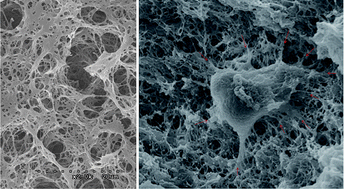Nanofibrous-structured biopolymer scaffolds obtained by a phase separation with camphene and initial cellular events
Abstract
A simple and novel methodology to create a

* Corresponding authors
a
Institute of Tissue Regeneration Engineering (ITREN), Dankook University, South Korea
E-mail:
kimhw@dku.edu
Fax: +82 41 550 3081
Tel: +82 41 550 3085
b Biomaterials and Tissue Engineering Laboratory, Department of Nanobiomedical Science & WCU Research Center, Dankook University, South Korea
c Department of Biomaterials Science, School of Dentistry, Dankook University, South Korea
A simple and novel methodology to create a

 Please wait while we load your content...
Something went wrong. Try again?
Please wait while we load your content...
Something went wrong. Try again?
S. Bang, T. Kim, H. Lee, U. S. Shin and H. Kim, J. Mater. Chem., 2011, 21, 4523 DOI: 10.1039/C0JM03108A
To request permission to reproduce material from this article, please go to the Copyright Clearance Center request page.
If you are an author contributing to an RSC publication, you do not need to request permission provided correct acknowledgement is given.
If you are the author of this article, you do not need to request permission to reproduce figures and diagrams provided correct acknowledgement is given. If you want to reproduce the whole article in a third-party publication (excluding your thesis/dissertation for which permission is not required) please go to the Copyright Clearance Center request page.
Read more about how to correctly acknowledge RSC content.
 Fetching data from CrossRef.
Fetching data from CrossRef.
This may take some time to load.
Loading related content
